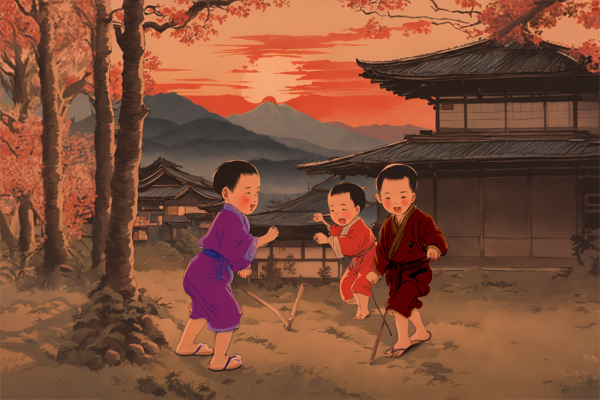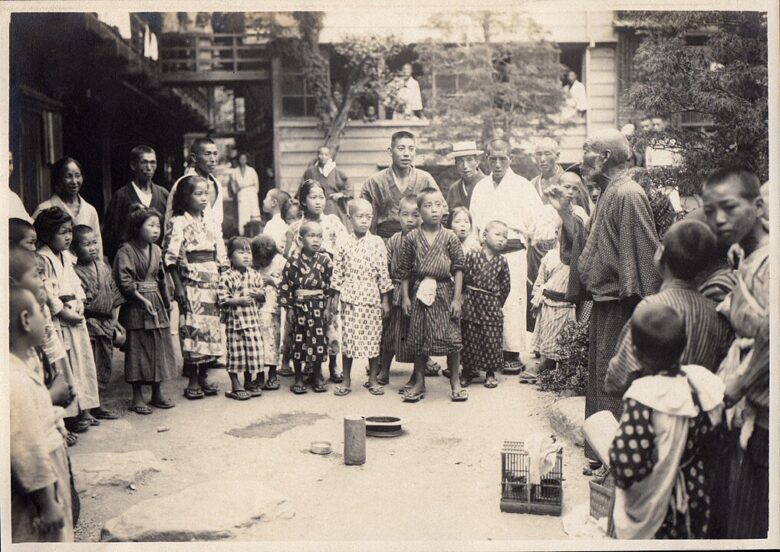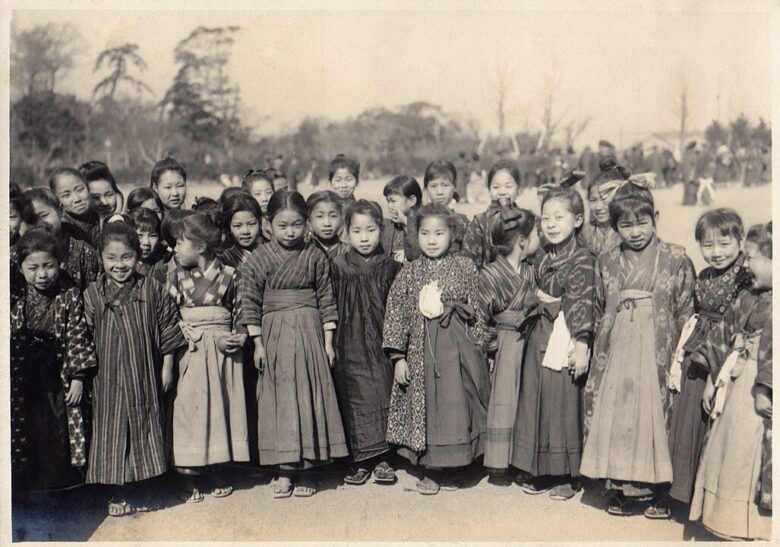Yuuhi
Ging-Ging-Gira-Gira, Yuuhi ga shizumu
Ging-Ging-Gira-Gira, Hi ga shizumu
Makka kakka sora no kumo
Minna no okao mo makkakka
Ging-Ging-Gira-Gira, Hi ga shizumuGing-Ging-Gira-Gira, Yuuhi ga shizumu
Ging-Ging-Gira-Gira, Hi ga shizumu
Karasu yo ohiwo okkakete
Makka ni somatte mattekoi
Ging-Ging-Gira-Gira, Hi ga shizumuLyricist : KUZUHARA Shigeru
Composer : MUROZAKI Kingetsu
in 1921
The sunset
“Ging-Ging-Gira-Gira” as the sunsets
“Ging-Ging-Gira-Gira” as the sunsets
“Makkakkakka” clouds in the red sky
Everyone’s face is also red “Makkakka”
“Ging-Ging-Gira-Gira” as the sunsets
“Ging-Ging-Gira-Gira” as the sunsets
“Ging-Ging-Gira-Gira” as the sunsets
Crow chasing the setting sun
Dyed in bright red and come dancing
“Ging-Ging-Gira-Gira” as the sunsets

The children’s song “Yuuhi” (The Sunset) was written in 1921 by KUZUHARA Shigeru, with music composed by MUROZAKI Kingetsu. It continues to be cherished for its depiction of nature’s beauty, with the phrase “Ging-Ging-Gira-Gira” standing out as a symbol of the song. This onomatopoeia vividly captures the intense light of the setting sun, conveying the power of the moment through the sound of the words. The sharpness of “Ging-Ging” mirrors the brilliance of the light, and the rhythm gives a sense of presence, as if one is witnessing the sunset firsthand.

Interestingly, this phrase was originally “Kin-Kin-Kira-Kira” (bright and shining like the morning sun). However, Kusakawa’s second-grade daughter suggested, “The morning sun may be ‘Kin-Kin-Kira-Kira,’ but shouldn’t the sunset be ‘Ging-Ging-Gira-Gira’ instead?” This suggestion led to the change in the lyrics, better capturing the strength and distinctiveness of the setting sun. This anecdote highlights how a child’s fresh perspective can influence even a refined work and underscores the importance of such genuine sensibilities in children’s songs.

The repeated phrase “makka-kakka” (deep red) further enhances the song’s simplicity and effectiveness. Its rhythmic repetition helps children easily memorize the song, while simultaneously conveying the image of the sky turning completely red. The rhythm and sound of these words create a sense of unity with the expanding colors of the sunset, making it easy for children to feel connected to the changing beauty of nature.
In 1921, despite the rapid urbanization, watching the sunset was still a part of everyday life for many children. The sight of the sky turning red at the end of the day was a shared experience, whether in the city or countryside. “Yuuhi” captures this universal moment, transforming a simple daily occurrence into a song that helps children feel the beauty of nature and the emotional resonance of a day’s end.
Expressions like “Ging-Ging-Gira-Gira” and “makka-kakka” go beyond mere description, appealing directly to a child’s senses. Shigeru Kusakawa skillfully used such childlike expressions to convey the wonder of nature through song. In addition, the melody is highly rhythmic, evoking the image of children’s light, playful steps. The rhythm naturally invites movement, allowing children to physically experience the joy of nature as they sing. “Yuuhi” was not just a song to enjoy but also a way for children to experience the grandeur and fleeting beauty of nature.

The Taisho period, when this song was created, reminds me of Kimetsu no Yaiba (Damon Slayer). This picture shows AI’s idea of “Kimetsu no Yaiba.






コメント